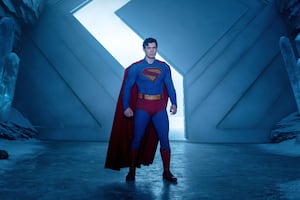In James Gunn's new Superman film, a sophisticated military attacks innocent civilians from across a border fence, with children's lives hanging in the balance.
If that imagery evokes the Israel-Gaza war in your mind, you're not alone.
Social media posts have claimed the film is a critical response to Israel's actions in Gaza.
The film is “very anti-Israel”, said a five-star review on the Letterboxd app, which has garnered nearly nine million views across platforms. Another post, with 11 million views on X, claimed the film's criticism is “very explicit and in your face”.
The film’s perceived political message has already been the subject of controversy. Gunn told The Times that the film is “about politics” and “morality”, and the film is an “immigrant” story, which sparked backlash among supporters of US President Donald Trump’s sweeping anti-immigration policies.
Neither Gunn, nor any of the cast and crew, have publicly claimed the story is about Israel or Palestine, but early audiences have pointed to one of the film’s main story threads as an allegory for the conflict.
But is the film about Israel and Palestine? It can certainly be interpreted that way, but it’s not as overt as many have claimed. Let’s break it down – minor spoilers to follow.
The film opens three weeks after Superman (David Corenswet) has prevented the fictional nation of Boravia – an ally of the US, we’re told – from invading the fictional nation of Jarhanpur.
Boravia has a sophisticated and heavily armed military through US support, while Jarhanpur is a poor nation that can do little to defend itself.
Early in the story, reporter Lois Lane (Rachel Brosnahan) interviews Superman about his actions in Boravia – moments of which appear in the film’s trailer.
“The secretary of defence says that he’s going to look into your actions,” Lois says to Superman. Superman responds: “My actions? I stopped a war.”
The film's trailer shows a scene from the Boravia-Jarhanpur conflict – the Boravian side full of tanks, military vehicles and soldiers with assault rifles, the Jarhanpurian side with unarmed civilians fleeing for their lives.
While there have been other real-life conflicts that mirror this dynamic, there is one reason in particular it feels more influenced by Israel-Palestine than it does, say, Ukraine-Russia. The Boravians are portrayed as ethnically white, while the Jarhanpurians are non-white.
Boravia’s plan, we’re told, is a settler-colonial project that aims to displace the indigenous Jarhanpurians and expand the Boravian state. The imagery also evokes scenes from the Gaza conflict, set in an arid environment with women wearing modest clothing.
In some scenes, Jarhanpurians approach the border between the two territories – a metal fence – and men, women and children march with sticks and rocks in their hands as Boravian’s point rifles at them from the other side of the dividing point. One young boy holds the flag of Superman, hoping to be saved as soldiers approach.
The discussions between the characters also mirror real-life debates around Israel and Palestine. In a scene in which Lois and Superman debate the morality of his intervention, Lois lays out a defence of Boravia – that an unchecked Jarhanpurian government could also be responsible for future bloodshed, which reflects arguments against Hamas. Superman, portrayed as an idealist, believes that stopping the conflict is the way to save innocent lives.

The Boravia-Jarhanpur conflict remains a focal point throughout the film, with the Boravian leader Vasil Glarkos (Zlatko Buric), who bears physical resemblance to Israel’s Prime Minister Benjamin Netanyahu, working with the film’s primary antagonist Lex Luthor (Nicholas Hoult). Lex, a key figure in the Boravian aggression, plans to take part of Jarhanpur for himself.
Lex Luthor, going back to the 1980s, has been directly modelled after US President Donald Trump.
“Of course, Donald Trump was our model,” Superman writer John Byrne told the Daily Beast in 2016. Years later, DC Comics released an “unauthorised biography” of Lex Luthor, with a cover modelled after the original cover of President Trump’s book The Art of the Deal.

The timeline of the film aligns with the Israel-Gaza war, too. Gunn was writing the film at the time of the October 2023 attacks by Hamas, saying he was 99 per cent done in December of that year. Filming began on February 29, 2024, and wrapped in July.
Gunn did comment on the conflict during that time, albeit obliquely. Before production began, Egyptian comedian Bassem Youssef announced that he had lost a role in the film due to comments he made about the Israel-Gaza war. Gunn clarified in February 2024 that Youssef had never been offered a role, though they had discussed the possibility.
Gunn wrote on Threads: “There isn’t one word against another. Bassem and I talked and we’re good. I understand how he thought things might be (which he was clear about in his interview), and I told him the whole story.”
While Gunn has stayed vague about the real-life parallels in the film – and both Boravia and Jarhanpur have appeared in comic books over the years – it's hard to imagine the Israel-Palestine resemblance is a coincidence.




